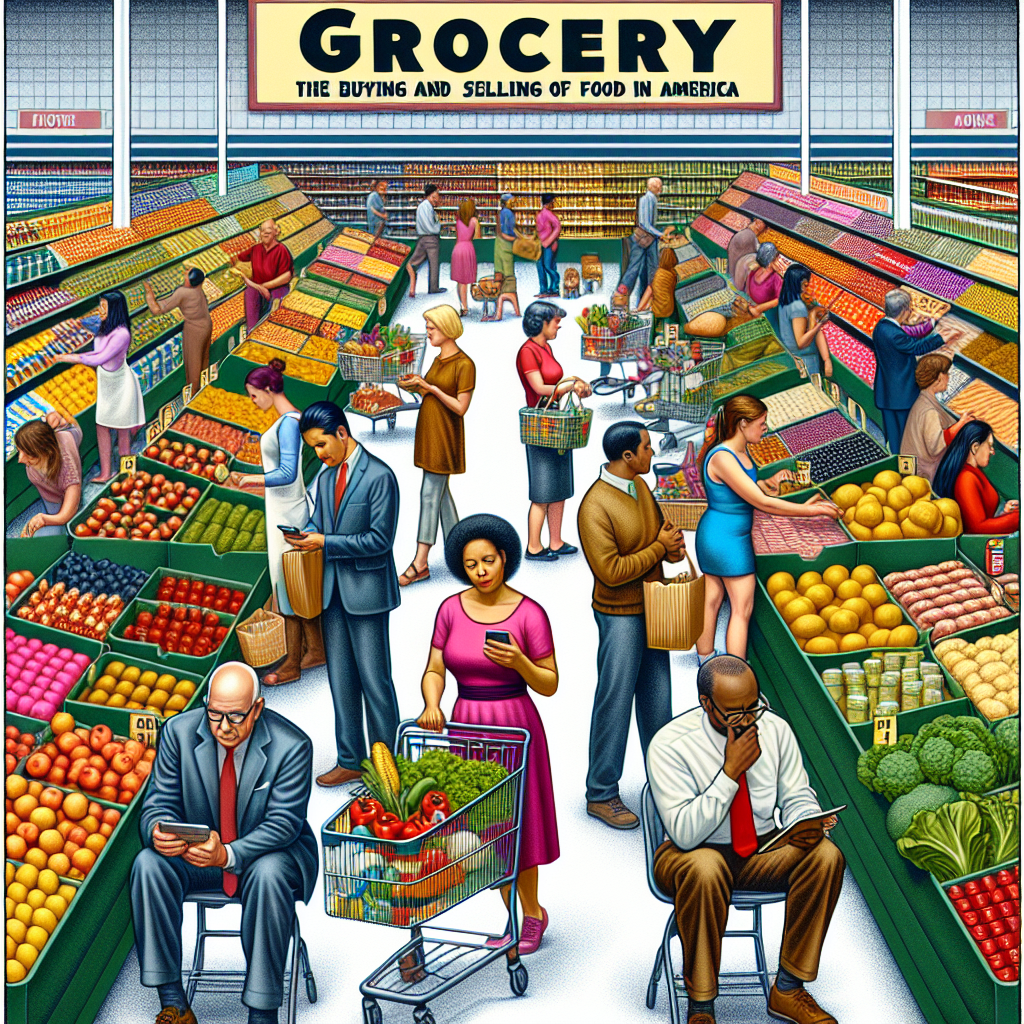As an Amazon Associate I earn from qualifying purchases.
### Unveiling the Hidden Truths of Grocery Stores: Dive into “Grocery: The Buying and Selling of Food in America”
In an era where the supermarket's aisles are overflowing with endless choices, Michael Ruhlman's “Grocery: The Buying and Selling of Food in America” offers an eye-opening exploration into the intricate world of food retailing. Ruhlman peels back the layers of this multi-billion dollar industry, revealing the hidden mechanisms that influence what ends up in your shopping cart. Say goodbye to your routine grocery run and hello to a newfound appreciation for the delicate balance between supply chains, consumer demands, and environmental impacts.
Understanding Grocery's far-reaching impact is pivotal, especially when factors such as health, sustainability, and even socioeconomic disparities come into play. This book not only uncovers the complexities behind food distribution but also addresses pressing issues like the food industry's role in public health, the ethical implications of sourcing, and the realities of food deserts. Through this enlightening journey, Ruhlman navigates these multifaceted problems, offering readers actionable insights and igniting conversations that extend well beyond the supermarket's automatic doors.
###
Plot
The book “Grocery: The Buying and Selling of Food in America” delves into the intricacies of the grocery industry and how it impacts the way Americans eat. Michael Ruhlman takes a closer look at the operations of Heinen’s, a family-owned chain in the Midwest, to provide a detailed portrayal of the complexities involved in running a grocery store. He navigates through various departments, from the meat and produce sections to the aisles of packaged goods, illustrating the challenges and triumphs of grocery management. The storyline also examines broader economic, cultural, and technological factors that shape the contemporary landscape of grocery retail.
###
Characters
The author seeks to bring personal perspectives to the topic by introducing key individuals in the grocery industry. For instance, Ruhlman profiles Tommy Heinen and his family, who have been running Heinen’s stores for generations. Their experiences and insights serve as a humanistic lens through which readers can understand the complexities of the grocery business. Additionally, Ruhlman introduces grocery store employees like butchers, bakers, and department managers, whose daily work embodies the core of grocery operations.
###
Writing Style
Michael Ruhlman's writing style is a harmonious blend of investigative journalism and narrative storytelling. His approach is both informative and engaging, using vivid descriptions and anecdotal evidence to breathe life into the subject matter. Ruhlman's prose is accessible yet detailed, designed to cater to both industry insiders and general readers. He employs a tone that is both authoritative and approachable, often integrating personal reflections to add depth to his examination.
###
Setting
The primary setting of the book centers around Heinen's stores located in Ohio, providing a grounded, real-world backdrop against which larger industry trends are explored. The setting also extends to other parts of the United States as Ruhlman discusses different grocery chains, markets, and the influence of regional preferences on grocery shopping habits. This geographical diversity allows readers to gain a comprehensive understanding of how grocery retail varies across different American landscapes.
###
Unique Aspects
One unique aspect of the book is its deep dive into the cultural significance of grocery stores in American society. Ruhlman examines how grocery shops have evolved from local markets to large-scale supermarkets, becoming integral parts of communities and daily life. Another unique feature is the book's attention to the technological advancements in the industry, such as the implementation of data analytics for inventory management and customer preferences. The book also explores sustainable and ethical considerations in grocery operations, such as organic produce and fair trade products, adding layers of complexity to the narrative.
Pros
Insightful Analysis of the Grocery Industry
The book provides a detailed and insightful analysis of the grocery industry, offering readers a comprehensive view of how food is bought and sold in America. This level of detail helps readers appreciate the complexities and challenges faced by retailers and suppliers. By understanding these intricacies, readers can become more informed consumers, which can positively impact their shopping experience.
Engaging Writing Style
Michael Ruhlman has a captivating writing style that makes the subject matter engaging and accessible, even for those who are not typically interested in the grocery business. His ability to blend facts, anecdotes, and personal stories creates a compelling narrative that keeps readers hooked. This makes the book not only educational but also enjoyable to read, enhancing the user experience.
Well-researched Content
The book is well-researched, drawing from interviews with industry experts, grocers, and other key stakeholders. This thorough research adds credibility to the information presented and allows readers to trust the insights and conclusions drawn by the author. Such in-depth research ensures that readers are well-informed about the industry's current state and future trends, adding value to their reading experience.
Exploration of Contemporary Issues
Ruhlman addresses contemporary issues such as organic food trends, sustainability, and the impact of technology on grocery shopping. This timely exploration makes the book relevant to today's readers who are increasingly concerned about these topics. By addressing these concerns, the book resonates with a modern audience and encourages them to think critically about their food choices.
Cons
Overemphasis on Personal Anecdotes
While personal anecdotes can make a narrative more engaging, Ruhlman sometimes overuses them, which can detract from the main points and make the book feel less focused. This overemphasis on personal stories may sidetrack readers who are looking for more factual and analytical content, potentially diminishing their user experience.
Lack of Diverse Perspectives
The book primarily focuses on large, well-known grocery chains and does not sufficiently explore smaller, independent grocery stores or alternative models like co-ops and farmers' markets. This lack of diverse perspectives can limit the reader's understanding of the full spectrum of the grocery industry. It may leave readers feeling that they only received a partial view of the market, which could impact the perceived comprehensiveness of the book.
Slow Pacing in Certain Sections
Certain sections of the book are slower-paced and can feel repetitive, which may test the patience of some readers. This uneven pacing can disrupt the flow and make it difficult for readers to stay engaged throughout the entire book. For readers who prefer a consistently brisk and dynamic narrative, this aspect can negatively impact their user experience.
Potential for Information Overload
Given its thoroughness, the book can sometimes present an overwhelming amount of information in a single chapter, making it challenging for readers to absorb and retain the key points. This potential for information overload might lead to confusion or fatigue, particularly for those who are not deeply familiar with the grocery industry. Such an experience could detract from the overall enjoyment and learning experience of the reader.
FAQ
What is “Grocery: The Buying and Selling of Food in America” about?
“Grocery: The Buying and Selling of Food in America” is a book by Michael Ruhlman that delves into the complex world of grocery stores and the food industry in the United States. It covers the history, economics, and behind-the-scenes operations of grocery chains, while also exploring how food gets from farms to store shelves and the changing landscape of consumer habits.
Who is the author of “Grocery: The Buying and Selling of Food in America”?
The book is authored by Michael Ruhlman, a well-known writer and journalist who specializes in food and cooking. He has written several other books on culinary topics and is highly regarded in the food writing community.
Is “Grocery: The Buying and Selling of Food in America” suitable for someone without a background in the food industry?
Yes, the book is written in a style that is accessible to general readers, regardless of their background. While it provides in-depth analysis and detailed information, it does so in a way that is engaging and easy to understand.
Does the book cover recent changes in the grocery industry?
While “Grocery: The Buying and Selling of Food in America” provides a comprehensive overview of the grocery industry, it was published in 2017, so it may not include the most recent developments. However, it does cover significant trends and changes up to its publication date.
Are there any real-life examples or case studies in the book?
Yes, Michael Ruhlman uses real-life examples and case studies to illustrate various points throughout the book. These examples help to bring the text to life and provide concrete illustrations of the concepts discussed.
What makes this book different from other books about the food industry?
“Grocery: The Buying and Selling of Food in America” stands out due to its focus on the grocery store as a critical nexus in the food supply chain. While many books explore aspects of food production or culinary culture, Ruhlman's work uniquely examines the pivotal role of grocery stores in shaping food availability, consumer choices, and broader food trends.
Would this book be useful for someone studying business or economics?
Yes, “Grocery: The Buying and Selling of Food in America” would be valuable for students or professionals in business or economics, particularly those interested in retail management, supply chain logistics, or food economics. The insights provided in the book offer a detailed look at the operational and economic complexities of running a grocery business.
Is the book more narrative or data-driven?
The book strikes a balance between narrative storytelling and data-driven analysis. Ruhlman employs a narrative approach to make the subject matter engaging but also integrates data and statistics to support his insights and conclusions.
How has the book been received by critics and readers?
“Grocery: The Buying and Selling of Food in America” has been well-received by both critics and readers. It has garnered praise for its thorough research, engaging writing style, and the unique perspective it offers on the grocery industry. Many reviews highlight its ability to make the complexities of the grocery business understandable and interesting to a broad audience.
Where can I purchase “Grocery: The Buying and Selling of Food in America”?
The book is available for purchase at most major bookstores, both online and in physical stores. You can find it on websites like Amazon, Barnes & Noble, and through independent bookstores. It's also available in various formats, including hardcover, paperback, and eBook.
In conclusion, “Grocery: The Buying and Selling of Food in America” by Michael Ruhlman is a compelling and meticulously researched book that is an invaluable choice for anyone interested in understanding the intricate world of the American grocery industry. Ruhlman's extensive exploration not only provides readers with a thorough historical context of how grocery stores evolved but also delves into the contemporary challenges and operational dynamics facing today’s grocers.
One of the key insights the book offers is a clear elucidation of the supply chain’s journey—from the farm to the supermarket shelf. Ruhlman demystifies the complex logistics involved in ensuring that products are available, fresh, and affordable to consumers. His behind-the-scenes narratives and personal interviews with industry professionals offer a perspective that is both enlightening and engaging. For readers who are curious about what goes into the everyday act of buying groceries, this book serves as an eye-opener, promoting a deeper appreciation for the unseen efforts that shape our food experiences.
Another benefit of delving into “Grocery” is the nuanced analysis of modern consumer behaviors and trends. Ruhlman’s inspection of the organic movement, local sourcing, and the rising demand for specialty foods provides a comprehensive understanding of how consumer preferences are reshaping the industry. Moreover, the exploration of how technological advancements and e-commerce impact traditional grocery shopping presents a forward-thinking narrative, making the book incredibly relevant in today’s rapidly evolving retail environment.
Ruhlman’s accessible writing style ensures that even complex concepts are approachable, making this book suitable for a wide audience—from industry insiders and food enthusiasts to everyday shoppers eager to gain insight into the food retail ecosystem. His balanced perspective, neither overly critical nor excessively laudatory, allows readers to form their own informed opinions about the multifaceted grocery world.
Ultimately, “Grocery: The Buying and Selling of Food in America” is not just a book—it is an educational journey that provides a wealth of knowledge about the food industry’s inner workings. Readers will walk away with a better understanding of the economic, social, and technological factors that drive the American grocery sector. Whether you are looking to enhance your knowledge, spark a personal interest in food logistics, or simply gain a newfound respect for the grocery store's role in everyday life, Ruhlman’s book is a must-read.
Amazon and the Amazon logo are trademarks of Amazon.com, Inc, or its affiliates.






















































